
The Northern Territory is an Australian internal territory in the central and central-northern regions of Australia. The Northern Territory shares its borders with Western Australia to the west, South Australia to the south, and Queensland to the east. To the north, the Northern Territory looks out to the Timor Sea, the Arafura Sea and the Gulf of Carpentaria, including Western New Guinea and various other islands of the Indonesian archipelago.

Ruby is a pinkish red to blood-red colored gemstone, a variety of the mineral corundum. Ruby is one of the most popular traditional jewelry gems and is very durable. Other varieties of gem-quality corundum are called sapphires. Ruby is one of the traditional cardinal gems, alongside amethyst, sapphire, emerald, and diamond. The word ruby comes from ruber, Latin for red. The color of a ruby is due to the element chromium.
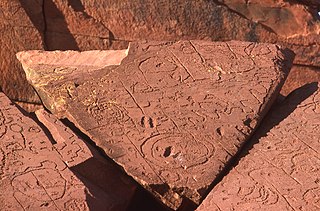
The protected areas of the Northern Territory consists of protected areas managed by the governments of the Northern Territory and Australia and private organisations with a reported total area of 335,527 square kilometres (129,548 sq mi) being 24.8% of the total area of the Northern Territory of Australia.
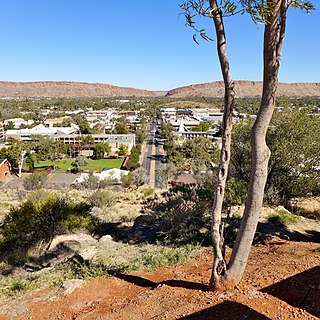
Alice Springs is a town in the Northern Territory, Australia; it is the third-largest settlement after Darwin and Palmerston. The name Alice Springs was given by surveyor William Whitfield Mills after Alice, Lady Todd, wife of the telegraph pioneer Sir Charles Todd. Known colloquially as The Alice or simply Alice, the town is situated roughly in Australia's geographic centre. It is nearly equidistant from Adelaide and Darwin.

Pine Creek is a small town in the Katherine region of the Northern Territory, Australia and is situated just off the Stuart Highway; it is 90kms north of Katherine. As at the 2021 Census there were 318 residents of Pine Creek, which is the fourth largest town between Darwin and Alice Springs.
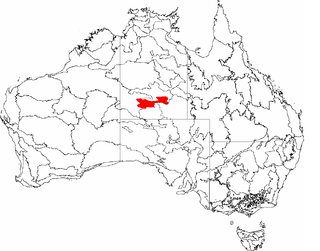
The MacDonnell Ranges, or Tjoritja in Arrernte, is a mountain range located in southern Northern Territory. MacDonnell Ranges is also the name given to an interim Australian bioregion broadly encompassing the mountain range, with an area of 3,929,444 hectares. The range is a 644 km (400 mi) long series of mountains in central Australia, consisting of parallel ridges running to the east and west of Alice Springs. The mountain range contains many spectacular gaps and gorges as well as areas of Aboriginal significance.
Mining is an important industry in Pakistan. Pakistan has deposits of several minerals including coal, copper, gold, chromite, mineral salt, bauxite and several other minerals. There are also a variety of precious and semi-precious minerals that are also mined. These include peridot, aquamarine, topaz, ruby, emerald, rare-earth minerals bastnaesite and xenotime, sphene, tourmaline, and many varieties and types of quartz.

During the Australian gold rushes, starting in 1851, significant numbers of workers moved from elsewhere in Australia and overseas to where gold had been discovered. Gold had been found several times before, but the colonial government of New South Wales had suppressed the news out of the fear that it would reduce the workforce and destabilise the economy.
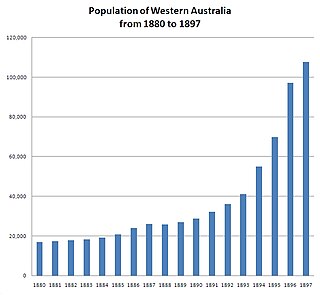
In the latter part of the nineteenth century, discoveries of gold at a number of locations in Western Australia caused large influxes of prospectors from overseas and interstate, and classic gold rushes. Significant finds included:

Arltunga Historical Reserve, known also as Arnerre-ntyenge is a deserted gold rush town located in the Northern Territory of Australia in the locality of Hart about 110 kilometres (68 mi) east of Alice Springs. It is on the lands of the Eastern Arrernte people who are the traditional owners.
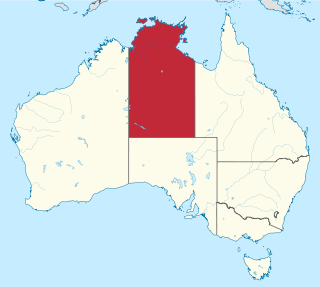
Mining in the Northern Territory accounts for 16.4% of the gross domestic product, inclusive of both the minerals and petroleum industries. In 2015, it was valued at A$3,436 million. It accounts for 4.3% of the Northern Territory workforce. 63 businesses are currently engaged in the sector.
Walter Smith also known as Walter Purula (Perrurle) or Wati Yuritja was a legendary Australian bushman from the Arltunga region in the Northern Territory of Australia. Wati Yuritja translates as man of the Water Dreaming).

Richard "Dick" Glyn Kimber was an Australian historian and author who wrote extensively on the history, art, culture and wildlife of Central Australia. He published several books, the best known of which is Man From Arltunga: Walter Smith, Australian Bushman (1986) as well as more than 100 articles and essays. He also gave public lectures and made regular media appearances.
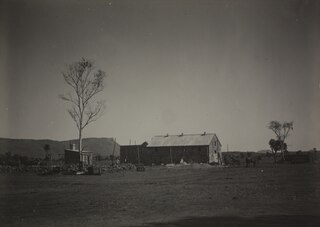
Stuart Town Gaol in Alice Springs, Northern Territory, Australia, located on 9 Parson Street, was constructed in 1907, when Alice Springs had a European population of approximately 30 people, and held its first prisoner in 1909. It is one of the earliest permanent buildings constructed in the town and the first government building. The gaol follows a simple design and was built, using local materials, by stonemason Jack Williams.

Gerhardt Andreas Johannsen was a stonemason, builder and pastoralist in the Northern Territory.
William Garnet South was a police officer in Alice Springs and Chief Protector of Aborigines. He was also, for a short period, proprietor of the Stuart Arms Hotel in Alice Springs.
Ross Highway is a road in the Northern Territory, Australia located to the south of Alice Springs.

The Hale River is a river in the southeast of Australia's Northern Territory. Most of the year, however, it has no water.
Anilios fossor, also known as the miner blind snake, is a species of blind snake that is endemic to Australia. The specific epithet fossor (“digger”) refers to the snake's fossorial habits as well as to the type locality.

The Winnecke Goldfield, sometimes known as Winnecke Depot Goldfield, is a now abandoned goldfield about 70 kilometres north east of Alice Springs and 50 kilometres north west of Arltunga. It is located within the Central Desert Shire Council region. It is on the lands of the Eastern Arrernte people who are the traditional owners and it is within the within the estate known as Inerentye.















